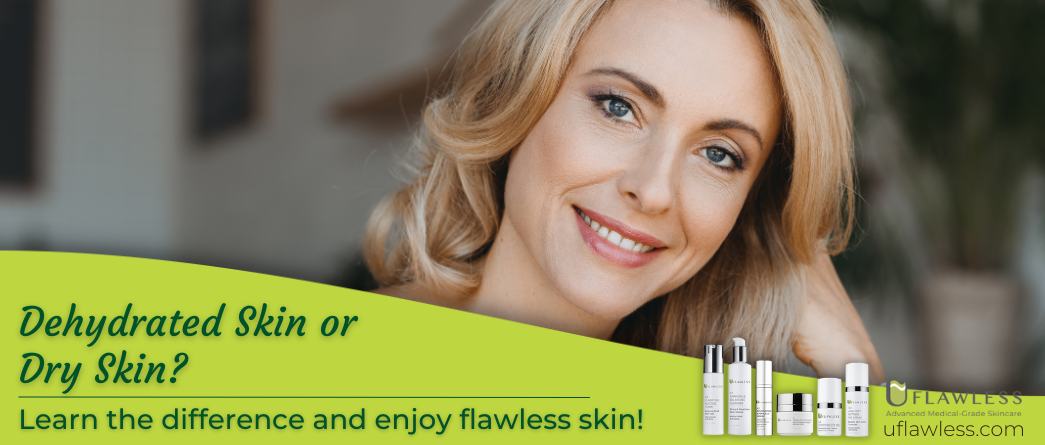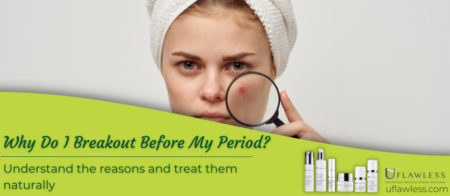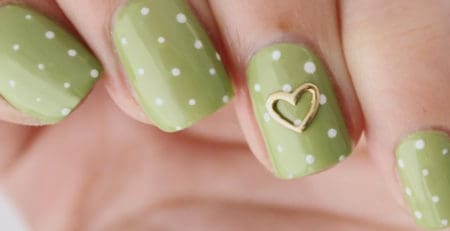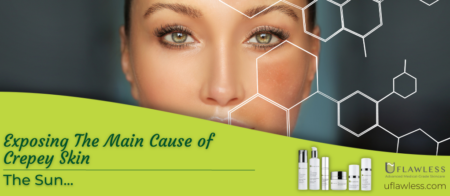Dehydrated Skin or Dry Skin? Is There a Difference?
Although dehydrated skin and dry skin might seem similar at first, they are fundamentally different when viewed through the lens of skincare.
Understanding the distinction is crucial for treating these conditions effectively.
Dry Skin refers to a skin type. It is characterized by a lack of oil (or sebum) production.
People with dry skin often experience roughness, flakiness, and sometimes even itchiness.
This is due to a genetic predisposition where the skin produces insufficient natural oils, impairing the skin’s protective barrier.
According to dermatological studies, dry skin is more common in older adults, as sebum production naturally decreases with age.
Dehydrated Skin is a temporary condition caused by a lack of water (moisture) in the skin, rather than oil.
This condition can affect any skin type, even oily or combination skin.
External factors, such as weather changes, lifestyle, or improper skincare routines, can lead to dehydration.
Dehydrated skin often feels tight, appears dull, and may show fine lines that are more noticeable due to the lack of moisture in the skin’s deeper layers.

Checking Dehydrated Skin
On the other hand, dehydrated skin shows its signs differently.
To check for dehydration, try making small facial expressions or lightly pinching yur skin.
If fine lines or wrinkles appear easily, especially when you squeeze the skin, this is a telltale sign of dehydration.
Unlike dry skin, dehydration is related to a lack of moisture (water) in the skin, not oil.
Dehydrated skin tends to look dull, and these temporary wrinkles can make it feel less supple.
Both conditions are undeniably frustrating—though we’ll avoid any harsh words here!
But treating them effectively requires understanding the differences, allowing you to achieve truly flawless skin.
Check out the image to easily visualize these differences, and we’ll dive deeper into each condition as we go along.
Diagnosis: How to Self-Check for Dry or Dehydrated Skin
Checking Dry Skin
The easiest way to check if you have dry skin is by gently rubbing areas like the skin near your eyebrows or the corners of your nose.
If it feels rough, like sandpaper, or if you notice flakiness and experience itching, these are classic signs of dry skin.
This rough texture occurs because dry skin lacks sufficient oils, causing the skin’s outermost layer to lose its protective barrier, leading to irritation and sensitivity .
Can You Have Dry and Dehydrated Skin at the Same Time?
Yes, it’s entirely possible—and more common than you might think.
A person might naturally have dry skin, meaning their skin lacks oil due to genetics.
At the same time, environmental factors, like spending long hours in air-conditioned rooms or skipping the use of a humidifier during colder months, can lead to dehydrated skin, where the skin lacks moisture.
So, How Can You Spot The Difference Between Dry Skin and Dehydrated Skin?
For dry skin, it’s often easy to notice symptoms like redness, itchiness, and flaky patches.
Since dry skin has an impaired barrier function, it becomes more prone to irritation and inflammation .
In contrast, dehydrated skin tends to exaggerate fine lines and dark circles, especially around the eyes, giving the appearance of tiredness—even if you’re well-rested.
This is due to the loss of water in the skin, making it less plump and elastic.
Recognizing and treating both conditions is straightforward.
- To address dehydrated skin, focus on hydrating your skin with a serum that contains ingredients like hyaluronic acid, which helps replenish moisture deep within the skin’s layers .
- For dry skin, it’s essential to moisturize. A good moisturizer will add oil to your skin and help trap water, preventing further water loss from the surface.
By combining a hydrating serum with a moisturizer, you’re effectively covering both bases: restoring moisture to dehydrated skin and replenishing the oils that dry skin lacks.
Exfoliation for Dry & Dehydrated Skin
Exfoliation is an excellent first step when addressing both dry and dehydrated skin.
By exfoliating at least once a week during your cleansing routine, you can help remove built-up dead skin cells that can otherwise lead to issues like clogged pores and breakouts.
When dead skin cells accumulate on the surface, they not only contribute to a rough texture but also create a barrier that prevents serums and moisturizers from penetrating effectively.
Exfoliating helps clear this barrier, allowing your skincare products to work more efficiently.
One effective way to exfoliate is by using salicylic acid.
This beta-hydroxy acid (BHA) is known for its ability to break down and “unglue” stubborn dead skin cells.
Unlike physical exfoliants that can sometimes irritate dry or dehydrated skin, salicylic acid gently dissolves the bonds between dead skin cells, promoting clearer skin without excessive scrubbing.

#Pro-Tip: When choosing a salicylic acid product, look for one with a low pH, ideally around 4.5. A lower pH enhances the acid’s exfoliating power, allowing for deeper penetration and better results without causing irritation. This is especially important for sensitive or dry skin types, as maintaining the skin’s natural acid mantle can help protect its barrier function.
Why Is a Serum Important for Dehydrated Skin?
Serums play a crucial role in treating dehydrated skin because of their lightweight formula and smaller molecular structure.
These smaller molecules allow serums to penetrate the skin more deeply than thicker creams or moisturizers, delivering powerful active ingredients to the layers where they’re needed most.
The purer the serum, the better it can reach the deeper layers of the skin, where essential components like hyaluronic acid, collagen, and elastin are naturally produced.
This deep nourishment helps support the skin’s natural regeneration process, promoting the growth of youthful skin cells and revealing healthier, more radiant skin.
For dehydrated skin, it’s especially important to choose serums that contain hyaluronic acid and antioxidants.
Hyaluronic acid is a superstar in skincare, known for its ability to hold up to 1,000 times its weight in water.
This makes it a key ingredient in maintaining skin hydration, plumping the skin, and giving it a more youthful, lifted appearance.
In fact, hyaluronic acid is the same ingredient used in injectable dermal fillers, which further demonstrates its power to retain moisture and provide volume to the skin.
Incorporating a serum with this ingredient into your routine helps lock in moisture, smoothing out fine lines and giving the skin a fuller, more refreshed look.
Snow Mushroom Extract: A Skincare Powerhouse
Snow mushroom extract has recently gained widespread popularity in the skincare world—and for good reason. This natural ingredient boasts 500 times the hydrating power of hyaluronic acid, making it a game-changer for anyone seeking plumper, more hydrated skin.
In practical terms, this means firmer, more elastic skin, along with an improved overall skin tone.
The moisture-binding properties of snow mushroom extract allow it to penetrate the skin and provide deep hydration, resulting in a healthier, more youthful complexion.
This is where the X3 Face Volumizer truly shines. Not only does it contain snow mushroom extract, but it also combines hyaluronic acid, ashwagandha, and fruit extracts, creating a powerful serum designed for those seeking immediate plumpness, elasticity, and improved tone.
Watch the entire video, so you can learn how to claim FREE Samples of Snow Mushroom Extract with other amazing medical-grade skincare products!
-
X3 Dermal Filler in a Bottle Routine |
Original price was: $339.00.$261.00Current price is: $261.00.
Enhanced Plumpness, Elasticity, and Tone
When customers tell us they feel like they’ve hit a wall with their skincare routine, we always reach for the X3 Revitalizing Stem-Cells Serum.
This serum is a state-of-the-art formula that takes skin rejuvenation to the next level.
It’s not just about one or two key ingredients—it’s packed with powerful antioxidants like lilac stem-cells, which help reduce inflammation and protect against environmental damage.
The serum also contains tetrahexyldecyl ascorbate, the most effective, skin-friendly form of Vitamin C, known for brightening and protecting the skin.
Combined with hyaluronic acid and marine algae peptides, it works to deeply nourish, hydrate, and revitalize the skin.
When used together, the X3 Face Volumizer and the X3 Revitalizing Stem-Cells Serum create an unbeatable combination for achieving youthful, glowing skin.
These two serums complement each other perfectly, providing the ultimate solution for anyone looking for enhanced hydration, elasticity, and overall skin health.
What’s the Best Moisturizer for Dry Skin?
When it comes to tackling dry skin, the X3 Firming Peptide Cream stands out as the best moisturizer available.
The primary concern with dry skin is the lack of oil production, which plays a critical role in maintaining the skin’s natural barrier.
Without sufficient oils, the skin loses its ability to retain moisture, leading to redness, itchiness, and flakiness—classic signs of dry skin.
This is where the X3 Firming Peptide Cream makes all the difference.
Formulated with 99.9% pure top-quality antioxidants like Lipochroman and Chromabright, alongside marine firming peptides, this cream works to trap moisture in the skin cells, creating a stronger, healthier skin barrier.
Not only does it help alleviate the discomfort associated with dry skin, but it also significantly improves the appearance of fine lines, wrinkles, and age spots.
Additionally, because dry skin is often sensitive, it’s important to use products that are gentle yet effective.
The good news is that the X3 Firming Peptide Cream is safe for sensitive skin, offering all the benefits of intense hydration without irritation.
With its unique formulation, the X3 Firming Peptide Cream is the perfect solution for those seeking a deep, nourishing treatment that restores hydration while smoothing and firming the skin.
Drink Water: The Most Affordable Solution for Dry & Dehydrated Skin
When it comes to caring for dry and dehydrated skin, we can’t emphasize enough how important it is to drink 8-12 glasses of water a day.
Water is one of the most accessible and cost-effective ways to keep your skin hydrated from the inside out.
Staying well-hydrated helps your skin maintain moisture, flushes out toxins from your body, and supports the delivery of essential nutrients to your billions of skin cells.
While topical treatments are important, drinking water works at a deeper level, promoting overall skin health and keeping your skin looking plump and fresh.
#Pro-Tip: To make your water intake more enjoyable, consider adding natural flavors like fresh fruits and vegetables. For a fun twist, try incorporating natural juices or smoothies, loaded with ingredients that are not only delicious but also packed with vitamins and antioxidants that benefit your skin.
This simple addition can make staying hydrated both refreshing and beneficial for your complexion.
Be Careful with Hot Showers… Not Good for Your Skin
You’ve probably heard this before, but it’s worth repeating: hot showers are not your skin’s friend.
Hot water can strip away the skin’s natural protective barrier, which is made up of essential oils that help keep your skin hydrated and protected.
This is especially true during the winter months, when we’re tempted to turn up the heat in our showers.
To keep your skin healthy, opt for warm water instead, and keep showers short to minimize the damage to your skin’s moisture barrier.
A Humidifier Can Help Your Skin Thrive in a Dry Environment
As mentioned earlier, your environment plays a crucial role in the health of your skin.
This is where a humidifier can be a game-changer, especially in dry environments or during colder months when indoor heating sucks the moisture from the air—and your skin.
A humidifier adds moisture back into the air, helping your skin maintain its hydration. One of the best ways to benefit from a humidifier is to run it at night while you sleep.
This not only improves the air quality you’re breathing but also keeps your skin moisturized and healthy while you rest.
Can Alcohol and Coffee Be Considered Enemies of the Skin?
When it comes to coffee, while some studies suggest it doesn’t directly dehydrate the skin, it’s important to remember that coffee is a diuretic.
This means it increases urine production, leading to greater water loss from the body.
So while your morning cup of coffee may not harm your skin directly, you’ll want to make sure you’re drinking enough water to stay hydrated.
Alcohol, on the other hand, is definitely not skin-friendly.
Whether consumed or applied topically, alcohol strips moisture from the skin, leaving it dehydrated.
As we’ve discussed, dehydrated skin can lead to more pronounced lines and wrinkles, making alcohol a known villain when it comes to skin health.
Here are some scientific data to support all the information about Dehydrated Skin and Dry Skin we provide to you!
- National Center for Biotechnology Information (NCBI), “Hyaluronic Acid and Skin Hydration”
- American Journal of Clinical Dermatology, “The Role of Antioxidants in Skin Health”
- Journal of Clinical and Aesthetic Dermatology, “The Role of Chemical Exfoliation in Skin Health”
















